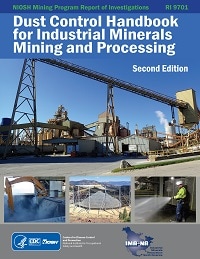Mining Product: Dust Control Handbook for Industrial Minerals Mining and Processing. Second edition.
Original creation date: March 2019
Authors: A Cecala, AD O'Brien, J Schall, J Colinet, RJ Franta, MJ Schultz, E Haas, J Robinson, J Patts, BM Holen, R Stein, J Weber, M Strebel, L Wilson, M Ellis
NIOSHTIC2 Number: 20055113
Pittsburgh, PA: U.S. Department of Health and Human Services, Public Health Service, Centers for Disease Control and Prevention, National Institute for Occupational Safety and Health, DHHS (NIOSH) Publication No. 2019-124 (RI 9701), 2019 Mar; :1-362
The second edition of this handbook represents a successful collaborative effort by government and industry toward protecting the health of U.S. mine workers. The two principal stakeholder partnerships active in creating this handbook were between the NIOSH Mining Program of the National Institute for Occupational Safety and Health (NIOSH) and the Industrial Minerals Association–North America (IMA-NA). The mission of the NIOSH Mining Program is to eliminate mining fatalities, injuries, and illnesses through research and prevention, while the IMA-NA is the representative voice of companies that extract and process raw materials known as industrial minerals.
This handbook was written by a task force of safety and health specialists, industrial hygienists, and engineers to provide information on proven and effective control technologies that lower workers’ dust exposures during all stages of mineral processing. The handbook describes both dust-generating processes and the control strategies necessary to enable mine operators to reduce worker dust exposure. Implementation of the engineering controls discussed can assist operators, health specialists, and workers in reaching the ultimate goal of eliminating pneumoconiosis and other occupational diseases caused by dust exposure in the mining industry.
Designed primarily for use by industrial minerals producers, this handbook contains detailed information on control technologies to address all stages of the minerals handling process, including drilling, crushing, screening, conveyance, bagging, loadout, and transport. The handbook’s aim is to empower minerals industry personnel to apply state-of-the-art dust control technology to help reduce or eliminate mine and mill worker exposure to hazardous dust concentrations—a critical component in ensuring the health of our nation’s mine workers.

NIOSHTIC2 Number: 20055113
Pittsburgh, PA: U.S. Department of Health and Human Services, Public Health Service, Centers for Disease Control and Prevention, National Institute for Occupational Safety and Health, DHHS (NIOSH) Publication No. 2019-124 (RI 9701), 2019 Mar; :1-362
- Control of Respirable Dust
- Dust Control Handbook for Industrial Minerals Mining and Processing
- Dust Underfoot: Enclosed Cab Floor Heaters Can Significantly Increase Operator's Respirable Dust Exposure
- The Effects of Water Spray Placement for Controlling Respirable Dust and Face Methane Concentrations
- Evaluation of the Approach to Respirable Quartz Exposure Control in U.S. Coal Mines
- Improved Drill Shroud Capture of Respirable Dust Utilizing Air Nozzles Underneath the Drill Deck
- Improving Silica Dust Control Through Targeted Research
- Laboratory Testing To Quantify Dust Entrainment During Shield Advance
- An Overview of Fundamental and Emerging Technologies to Monitor and Control Respirable Dust in Underground Coal Mines in the United States
- Performance of a Light Scattering Dust Monitor at Various Air Velocities: Results of Sampling in the Active Versus the Passive Mode
- Research by NIOSH for Controlling Respirable Dust and Methane Gas on Continuous Miner Faces